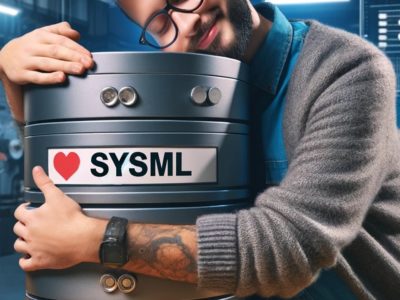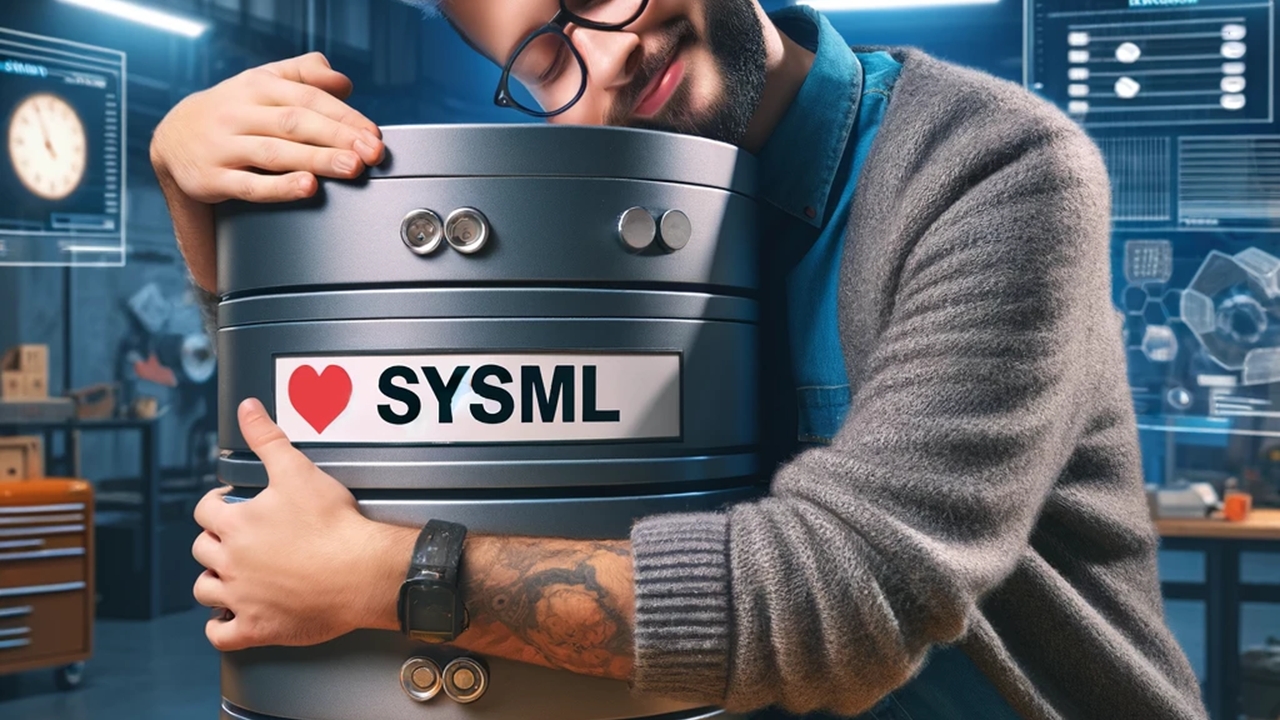Next Generation SysML v2 Guide for Microlearners
Learn little, learn often, learn sustainably This course consists of several microlearning units. You can do them in any order at your own pace. Each knowledge lesson lasts only a few minutes. This makes it easy to incorporate into your …
Overview
Curriculum
- 31 Sections
- 99 Lessons
- Lifetime
Expand all sectionsCollapse all sections
- Guide to the SysML v2 Learning Club - How to startThis is not yet a real learning unit, but only a short guide to the club. If you have already discovered and seen it on the club page, you can simply skip it.1
- History of SysMLLearn the origins of SysML as part of its context. It is helpful to classify SysML in general and to understand the different viewpoints that people have on SysML. It also partly explains why SysML is the way it is.4
- Quick Overview SysML v2Before you dive into individual topics of SysML v2, you will get a quick overview from a bird's eye view.3
- SysML v2 Modeling ToolsA brief introduction to SysML v2 modeling tools and explanation of how to choose a SysML v2 tool for the club to learn.4
- A Simple ExampleWe don't want to bore you with theory for too long. Therefore, we jump into the cold water and start with a simple example.3
- Foundations of SysML: Elements, Relationships, and DependenciesElement and Relationship are the basis for all SysML model elements. Dependency is a general concrete relationship.4
- Foundations of SysML: Definition and UsageThe separation of definition and usages is a common principle in modeling languages. Before we dive into the details of SysML v2, it is important to know the fundamentals on which many elements are based.4
- Foundations of SysML: SpecializationsIn addition to definitions and usages, the concept of specializations is another fundamental concept of SysML v2.3
- Namespaces and PackagesThe more we model, the more model elements we get. A little order is good.4
- FiltersYou can use filter conditions to selectively import elements into a package.2
- Views and ViewpointsViews are the key elements to show the model content to stakeholders.3
- Binding and AssignmentLooks similar - but it's not. Here you can learn the difference between binding and assignment.3
- AnnotationsAnnotations are little helpers that make a model easier to understand.3
- Common BehaviorIn addition to the modeling of structures, modeling is another important pillar of SysML v2. This learning unit initially only provides an overview.3
- Structures - BasicsThe essential foundations have been laid, let's get started with the modeling of structures.3
- Structures - Connecting the PartsThe learning unit "Structures - Basics" presents the basics of modeling structures. The focus there is on the parts. This learning unit is about the connections between parts.3
- Basics of Action ModelingActions are a broad field in SysML v2. This learning unit starts quite simply with the basics. Some of them have already been introduced in the learning unit on behavior in SysML v2.4
- More Action Modeling - DecisionsThe modeling of processes is a broad field. Here you will learn how to model decisions.4
- More Action Modeling - ParameterIt's just a detail in the modeling, but it can give you a headache if you don't understand how it's connected: the modeling of parameters.3
- Modeling of Use CasesUse cases are an integral part of requirements analysis and are of course also included in SysML v2.4
- Textual RequirementsRequirements are elementary. You can learn how to model textual requirements here.5
- Formalized RequirementsSysML v2 can do more than just textual requirements. Learn how to formalize your requirements here.3
- Basics of State ModelingHere you will learn the basics of state modeling.4
- Enumerations, Attributes, Quantities and UnitsEnumerations and attributes are fundamental structural elements used to represent values in a system model. Some of these values are associated with units. Quantities and units provide essential context—without a unit, “42” is just a number. The Behind the Scenes: Quantities and Units learning nugget explains how they work and why this knowledge is crucial if you plan to define your own quantities and units.8
- 24.1Learning Nugget – Enumerations5 Minutes
- 24.2Exercise: Read the “Enumerations” Learning Nugget Script
- 24.3Learning Nugget – Quantities and Units3 Minutes
- 24.4Exercise: Read the “Quantities and Units” Learning Nugget Script10 Minutes
- 24.5Quiz of the Week: Quantities and Units5 Minutes
- 24.6Learning Nugget – Quantities and Units – Behind the Scenes8 Minutes
- 24.7Exercise: Read the “Quantities and Units – Behind the Scenes” Learning Nugget Script15 Minutes
- 24.8Exercise: Create your own Unit20 Minutes
- Flows and MessagesFlows and messages are model elements for transferring payloads between elements. This happens both between structural elements and between behavioral elements.2
- Domain-Specific Language ExtensionsSysML is a general-purpose language. This makes it very general. Language extensions can be used to adapt it to specific domains.3
- SysML v1 to v2 TransformationShort stopover before we continue modeling SysML v2. What will actually become of the SysML v1 models?3
- Modeling with Cameo Systems ModelerThis chapter contains special learning units with Cameo Systems Modeler.1
- Modeling with SysIDEThis chapter contains special learning units with SysIDE.1
- Modeling with SysONThis chapter contains special learning units with SysON.1
- SYSMODThis chapter walks you step by step through the ZigZag pattern of the SYSMOD approach.3
Instructor
Features
- 1st class information from SysML v2 experts
- Regular updates
- Attached community


